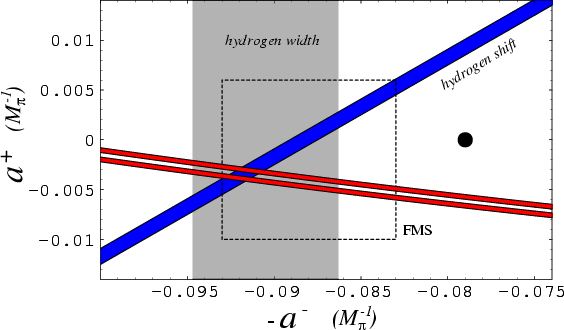The pion-deuteron scattering length was computed to
next-to-next-to-leading order in baryon chiral perturbation theory
(![]() PT) [39]. We then
formulated a modified power-counting which properly accounts for
infrared enhancements engendered by the large size of the deuteron, as
compared to the pion Compton wavelength.
The new ingredient in this more practical power-counting is the
observation that one may develop a hierarchy between the pion mass,
PT) [39]. We then
formulated a modified power-counting which properly accounts for
infrared enhancements engendered by the large size of the deuteron, as
compared to the pion Compton wavelength.
The new ingredient in this more practical power-counting is the
observation that one may develop a hierarchy between the pion mass,
![]() and the deuteron binding momentum,
and the deuteron binding momentum, ![]() . One can then pick
out the pieces of the amplitude that become large in the formal limit
in which
. One can then pick
out the pieces of the amplitude that become large in the formal limit
in which ![]() goes to zero and
goes to zero and ![]() is held
fixed [40]. This does not, of course, indicate that anything is
amiss with baryon
is held
fixed [40]. This does not, of course, indicate that anything is
amiss with baryon ![]() PT power-counting. Baryon
PT power-counting. Baryon ![]() PT should work
just fine for
PT should work
just fine for ![]() -d scattering in the threshold region, but
high-order calculations are required if truly accurate results are desired.
The advantage of the modified power-counting, and of EFT generally, is
that it immediately isolates the large contributions, without
requiring explicit calculations of matrix elements that end up being
smaller than the theoretical error.
We use the precise experimental value of the real part of the
pion-deuteron scattering
length determined from the decay of pionic deuterium, together with
constraints on pion-nucleon scattering lengths from the decay of
pionic hydrogen (See Fig. 5), to extract the isovector and
isoscalar S-wave
pion-nucleon scattering lengths,
-d scattering in the threshold region, but
high-order calculations are required if truly accurate results are desired.
The advantage of the modified power-counting, and of EFT generally, is
that it immediately isolates the large contributions, without
requiring explicit calculations of matrix elements that end up being
smaller than the theoretical error.
We use the precise experimental value of the real part of the
pion-deuteron scattering
length determined from the decay of pionic deuterium, together with
constraints on pion-nucleon scattering lengths from the decay of
pionic hydrogen (See Fig. 5), to extract the isovector and
isoscalar S-wave
pion-nucleon scattering lengths, ![]() and
and ![]() , respectively. We find
, respectively. We find
![]() and
and
![]() .
.
 |